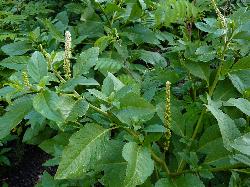- Taxon
- Weed
- Gallery
Glabrous, spreading or ± erect subshrub to c. 2 m tall, with numerous white raphides on stems and lower surface of lvs. Stems softly woody towards base, often reddish. Petioles to 2.5 cm long, moderately thick, often reddish. Lamina 4–15–(20) × 1.5–5 cm, elliptic or elliptic-ovate; base cuneate to attenuate; apex acute or mucronate. Racemes erect, to c. 7 cm long at maximum flowering, to c. 11 cm long at fruiting; peduncles and very short pedicels ± granular, becoming crimson at fruiting. Fls ☿, dense. Bracts 3–4 mm long, linear-lanceolate to subulate; bracteoles much smaller. Perianth 5–7 mm diam.; tepals accrescent, 2–3 mm long, broad-ovate, imbricate, whitish or pale greenish at first, becoming pink to crimson at fruiting. Stamens 8–(10), slightly < perianth; anthers white. Ovary (7)–8-carpellate, green with numerous white raphides. Fr. c. 8 mm diam. when fresh, depressed globose, with 8 very shallow and often inconspicuous grooves (prominent in dried specimens), shining black, very succulent with dark red juice. Seed 2–2.5 mm diam., subglobose, glossy black.
[From: Webb et al. (1988) Flora of New Zealand. Volume 4.]
Flowering: Nov.–Aug.




